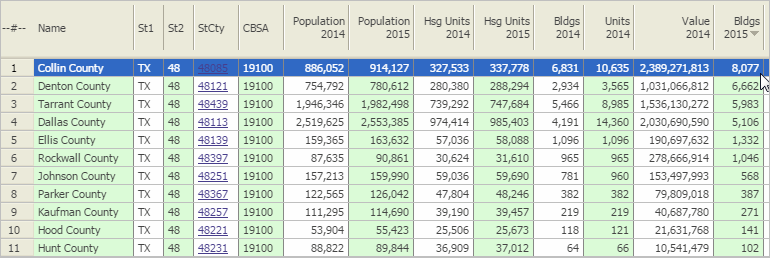.. what’s happening in the north Dallas metro? .. a lot, take a look at the patterns of new residential construction for Collin and Denton counties using data and tools presented in this section. Examine new residential construction, leading economic indicator, for counties and regions of interest to you anywhere in the U.S. Use of the Regional Demographic-Economic Modeling System (RDEMS) to examine patterns of residential construction in context of related wide-ranging, multi-sourced data.
This section provides a summary of new housing units authorized by building permits for new residential construction for each/all counties. Use data analytics tools and data described here analyze these data and related housing issues.
• interactive data analytics – details/access
• use GIS project/datasets – details/access
• access individual county profiles – details/access
Patterns of New Authorized Residential Units by County
The following graphic shows the 2015 per capita value of total units authorized by county. The four largest Texas metros are shown with bold brown boundaries.
See about subject matter included in datasets.

View created with CV XE GIS. Click graphic for larger view.
Additional views with counties labeled with name, 2015 housing units and 2015 total new housing units authorized.
• Charlotte, NC-SC metro by county
• Dallas, TX metro by county
• Houston, TX metro by county
Leading Economic Indicator
Building permit data (housing units authorized by building permits for new residential construction) are economic leading indicators. Investors and housing developers use these data to examine the characteristics and trends in new residential housing development. The short time lag between the data reference date and data access date, 1-2 months, makes this set of indicators important in assessing the current situation and patterns during the past year or more. The national scope coverage and geographic granularity (state, metro, county and city) enable comparison among types of areas and peer groups. Finance and real estate professional and researchers examine building permit patterns to develop strategic insights. Government and policy makers use these data to get a pulse on markets and changing patterns to administer programs and operations. See more about these data below in this section.
New residential construction begins with building permits. Overall U.S. housing starts are approximately 2.5% less than permits issued (22.5% less for multi-family units). Completions are approximately 4% less than starts (7.5% less for multi-family units). During the past year-plus, “residential fixed investment” has been approximately $500 billion and remained steady at 3.1% of real Gross Domestic Product.
Access Individual County Profiles
The following graphic illustrates use of the Regional Demographic-Economic Modeling System (RDEMS) to access the HSG1 Housing Units & New Residential Construction tables for a selected county. Click graphic for larger view.
Mecklenburg County, NC [37119] located in the Charlotte, NC-SC metro

Add a link to your Web page for areas of interest: The URL structure for Mecklenburg County is:
– http://proximityone.com/rdems/1/rdems37119hsg1.htm
– more in general, substitute the county state+county FIPS code (37119 in this case) to access a county of interest.
Using the Interactive Table
The interactive table includes a row for each county. Column structure and content are described below the table.
• Click the StCty link to view the housing unit/new construction profile.
• Select a metro to examine component counties
The following graphic illustrtaes use of the table to examine characteristics of the Dallas metro counties. Click graphic for larger view. 
Join me in a Data Analytics Lab session to discuss more details about accessing and using wide-ranging demographic-economic data and data analytics. Learn more about using these data for areas and applications of interest.
About the Author
— Warren Glimpse is former senior Census Bureau statistician responsible for innovative data access and use operations. He is also the former associate director of the U.S. Office of Federal Statistical Policy and Standards for data access and use. He has more than 20 years of experience in the private sector developing data resources and tools for integration and analysis of geographic, demographic, economic and business data. Contact Warren. Join Warren on LinkedIn.









